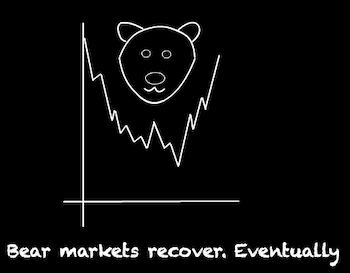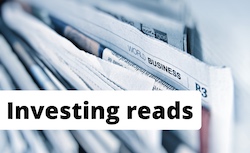After we all spent months anxiously awaiting the start of Rachel Reeves’ Budget 2025 speech, it was the Office for Budgetary Responsibility (OBR) that broke first.
Like a twitchy sprinter in the 100m who jumps the starter’s gun, the OBR went early and published its assessment of the budget – complete with most if not all of the contents of Reeves’ speech – more than half an hour before she got up to speak in the House of Commons.
Of course it was probably a computer glitch rather than sheer excitement on the OBR’s part. But where is the colour in that?
Either way, the unprecedented leak caused market-moving mayhem such as this for homebuilders:

Source: Google Finance
And this for UK gilts:

Source: Google Finance
The chancellor stood up just after 12.30pm. So you can see from the graphs when the details leaked – and the bungee jump that assets made on the news.
It’s curious to ponder why, say, builders moved like this.
One possibility is some naive trading algorithms responded to news of taxes on property, without taking into account other offsetting factors in the budget.
More likely though (or as well) is that these moves reflect trading entities caught offside by not expecting any news until 12.30pm, and then new money piling in on the leak overwhelming those prior strategic positions.
But I’m just speculating and I’m looking forward to reading more about it.
Hot takes on the budget 2025 announcements
Anyway, emboldened by the OBR, I’ll also not wait. Below are my first takes on the major points in the budget, unsullied by the opinions of others. (Well, not counting the last three month’s worth of pundit pontifications…)
I won’t go much into the economic and fiscal upgrades or downgrades.
But I will note that where the budget’s impact is disinflationary (such as reducing household energy bills) that should dampen inflation and gilt yields.
In turn that should bring down gilt yields – and by extension government borrowing costs. A good thing!
Timed to imperfection
In fact, this budget is arguably a missed opportunity to make deeper upfront moves to shore up the public finances, and so curb borrowing costs sooner.
“No one likes us and we don’t care,” sing Millwall fans. Given nobody currently likes Labour either, perhaps we might have seen bolder cuts and hikes.
Being tough now could have injected more life into the UK economy – not least through lower mortgage rates. That could even have seen Labour in a better position ahead of the next election, rather than seems likely with this dispiriting status quo.
Politically, however, both Reeves’ backbenchers and the electorate-at-large seem to have little patience for either welfare cuts or explicitly higher taxes.
Hence this stealthy muddle. And also a gilt market left to guesstimate how much of the back-ended higher revenues will actually materialise.
Why meeee?
Let’s also acknowledge it’s hard to cheer a tax rise that affects oneself. Or to be too viscerally concerned about benefit cuts for others.
Monevator readers are – like me – drawn from a certain slice of the population. Like most of you I don’t love the trajectory of public spending. I’d also prefer a focus on growth to get us out of the debt trap.
But realistically nothing in this budget will move the dial like the economic damage from Brexit, nor Reeves’ foolish decision to hike employers’ national insurance contributions in the last budget.
This budget is mostly just fiddling at the sides. It’s driven by politics and the kind of spreadsheet maths familiar to anyone who has ever tried to make a holiday rental property add up.
So from that perspective, here are my first takes on the most Monevator-adjacent bits. I look forward to reading yours below!
Note: bullet point summaries are from the budget document where possible.
Tax thresholds frozen for three more years until 2031
- The government is maintaining personal tax thresholds and the National Insurance contributions (NICs) secondary threshold from 2028 until 2031. And also the Plan 2 student loan repayment threshold from 2027-28 until 2029-30.
The showpiece tax generator. Reeves says is worth an extra £7.6bn a year by 2030 from income taxes alone. With NICs some £8.6bn by 2030-2031.
There are pros and cons, besides its tax-raising and political efficacy.
The biggest plus is it effectively postpones the pain versus a straight tax hike. Given the economy remains lacklustre at the moment, that’s no small thing.
For me the big negative is it’s stealthy and confusing. It also feels somehow more anti-aspirational than, say, increasing the basic rate of tax by 2p – even if it’s ultimately less costly to most taxpayers.
It’s also a strangely unprogressive move for a Labour government.
Millions more unspectacular earners will be paying higher-rate taxes by 2030. Indeed according to Hargreaves Lansdown over six million more people are paying income tax compared to 2021 when the freeze was first introduced. It says that’s worth an extra £89bn in income taxes a year.
Broadening the taxpaying base doesn’t seem the worst thing in the world to me. We’ve all seen those graphs showing how most income tax is paid by the very highest earners.
Still, I’d rather see a comprehensive revamp and simplification of the whole tax regime.
Cash ISA allowance curtailed to £12,000 a year
- From 6 April 2027 the annual ISA cash limit will be set at £12,000, within the overall annual ISA limit of £20,000.
- Annual subscription limits will remain at £20,000 for ISAs, £4,000 for Lifetime ISAs and £9,000 for Junior ISAs and Child Trust Funds until 5 April 2031.
- Savers over the age of 65 will continue to be able to save up to £20,000 in a cash ISA each year.
At least there’s no silly Dad’s Army ISA. But this is still a needless complication that won’t do much to boost investment.
I haven’t seen the small print – and there will be plenty – as to how cash-like you can get in your non-cash ISA. If you can hold Money Market Funds or short-term gilts, then for Monevator readers this will be a nothing burger.
Years ago though there were rules against that sort of thing in stocks and shares ISAs, so we’ll have to wait and see. Nothing happening until 2027.
Interestingly, shares in wealth managers rose today. Optimistically you might think that’s because they’ll see more money coming from banks’ cash ISAs.
But maybe it just reflects how average punters will be yet more confused about ISAs, and so more likely to hand their money over to St James Place.
Anyway, as someone who has been explaining ISAs here and offline for nearly 20 years, I know this move will confuse people.
Talking of complications, there is talk of a new ‘simpler’ ISA to support home buyers. It will replace the Lifetime ISA. More to come in early 2026.
The High Value Council Tax Surcharge (aka Mansion tax)
- The government is introducing a High Value Council Tax Surcharge (HVCTS) in England for residential properties worth £2 million or more, from April 2028.
- This charge will be based on updated valuations to identify properties above the threshold. It will be in addition to existing Council Tax.
- New charges start at £2,500 per year, rising to £7,500 per year for properties valued above £5 million.
- It will be levied on property owners rather than occupiers.
I suppose it could have been worse. The government says fewer than 1% of properties will affected.
Otherwise, after many months of speculation about such a measure – which has already slowed the property market – we’re all familiar with the arguments.
The main pro, if you believe in this kind of thing, is it taxes wealth that is growing disproportionately at the high end versus the general population.
The cons are multiple. The cost and faff of valuation, the cliff edge introduced and likely shenanigans around it, the difference between asset-rich and having the cashflow to pay a surcharge, and the arbitrariness of hitting property.
On at least the latter point – I’ll live.
The tax system is riddled with cliff edges and arbitrary measures. I spent 20 years as a renter who invested my money instead – with a limited annual tax-free sheltering capacity – while friends made six or even seven-figure sums tax-free from their homes. Meanwhile I paid capital gains tax on relatively modest unsheltered share gains.
Also, UK homes are in limited supply and, as just stated, gains on your own home have hitherto been tax-free. So there’s an argument UK property is a special case worthy of a wealth tax. This in addition to the practical fact that a house can’t go anywhere!
On the other hand, people will rightly fear this could be the thin end of the edge, as we saw with dividend taxes (see below).
Once the medicine has been swallowed, who’s to say a chancellor won’t eye up homes worth over £1m next? In much of London that doesn’t get you anything beyond a 900 sq ft Victorian terrace or a nice flat. Hardly a mansion.
At least we won’t have issue of prices shooting up above the £2m threshold for a while. The property market has been going backwards in real terms in the South East for over a decade. This is hardly going to spark a revival.
Salary sacrifice curbed to £2,000 limit
- The government is to limit the value of salary sacrificed pension contributions that can receive employee and employer NICs relief to £2,000 per year from 6 April 2029
I liked Finumus‘ initial take: “Now I know my retirement date.”
As a site that promotes self-reliant saving and investment, there’s no way Monevator can applaud this move.
Something immediately attractive – an income today – was being traded for future security – a pension.
Isn’t that what the government wants to encourage? Remember there are other restrictions on pension contributions and the like, to curb any alleged excesses.
Thus it looks like a short-term tax grab aimed at relatively wealthy workers. Politically understandable but yet another example of moving the goalposts and fostering a fundamentally unstable and hard-to-track savings regime.
I do not commend it to the house.
Dividend tax, property, and savings tax hiked
The government is:
- Creating separate tax rates for property income. From April 2027, the property basic rate will be 22%, the property higher rate will be 42%, and the property additional rate will be 47%.
- Increasing the ordinary and upper rates of tax on dividend income by 2 percentage points from April 2026. There is no change to the dividend additional rate.
- Increasing the tax rate on savings income by 2 percentage points across all bands from April 2027.
I don’t see anything to like about the dividend and savings rate increases. But I would say that, wouldn’t I? The only mitigation is the £20,000 ISA allowance remains intact. So for a lot of people most of their savings should be sheltered.
Still, the way dividend taxes were hiked years ago and an initial and relatively low dividend allowance slowly whittled away has been insidious. I used to write a lot about this, as I knew of people with large unsheltered portfolios who had eschewed using ISAs and SIPPS when they had a chance.
That’s the trouble with rules changing under your feet. But I suppose the bulk of that generation has passed away by now.
Another issue with dividend taxes is it effects those operating through limited companies. Again, little love from the mainstream for such people, but it all reflects a climate in which entrepreneurialism or running a small business is less attractive than it was a couple of decades ago. Is that what we want?
As for property, there’s only so much coshing the rental sector can take.
Two-child benefit cap scrapped
- The two-child limit in the Universal Credit Child Element will be removed from April 2026.
Clearly one for the Labour party faithful. But I do find it hard to get worked up about this. In fact on balance I think I probably support it.
Yes, I understand the argument that, effectively, middle-class strivers are paying for other people’s feckless decision to have more kids. I linked to a Telegraph article last week that directly correlated lower incomes with larger family sizes via a striking graph.
But let’s be honest, middle-class families could have more children if they wanted to. That’s provided they were prepared to live more like a family on benefits, in a crappier part of town, in insecure or council-owned property, and with a lower standard of living. Perhaps not for the marginal edge cases, but certainly for most Telegraph readers.
No, they don’t have more kids because they don’t want them nor the lifestyle impact of paying for bringing up larger broods in the manner they’ve become accustomed to. I totally understand that too – I have no children, and it’s no accident – but let’s not pretend the decision turns on an extra £17.25 a week.
And perhaps it is true that throwing more money at poorer large families could deliver a return for society, if it means better educational outcomes and more productive workers 18 years hence.
One thing is certain – the only person who doesn’t have a voice in all this is the third or fourth kid in that large poor family.
If extra benefit helps the helpless achieve better life outcomes, then isn’t that what a welfare state should be for?
Fiddling while Reading burns
Whether these relatively modest moves warranted the three months of will-she, won’t-she debate we lived through is – ahem – debatable.
We’ve had prime ministers that were in and and office in much less time than we’ve kicked all this around.
On that point though, some good news! We’ll only have one ‘fiscal event’ trigger a year going forward.
From Reuters:
Britain’s Office for Budget Responsibility will check if the government is meeting its budget rules once a year instead of twice, it said on Wednesday, according to its outlook unexpectedly published ahead of finance minister Rachel Reeves delivering her budget.
The OBR will continue to publish two sets of forecasts annually to accompany the government’s spring and autumn fiscal statements.
But, they will now only look once per year at whether the finance minister is on course to meet her targets for the public finances.
The International Monetary Fund had recommended that the OBR assess the government’s progress towards its fiscal rules only once a year to reduce speculation about what measures might be needed to stay on track.
You might argue this amounts to less oversight on the government.
But watching the forecasts oscillate about and, again, the endless speculation about what might be done in response has not been edifying. Nor, I’d argue, has it been good for businesses, households, or the economy writ large.
Hence I’m all for this change.
And there’s more…
For the rest of the budget details, check out summaries from:
You want to know the nerdiest details about capital spending allowances for widget makers or whatnot?
- Read the official budget document via the Gov.UK website
I look forward to your groans and hurrahs (only joking) in the comments. Please let’s keep the discussion as constructive as possible. 🙂






